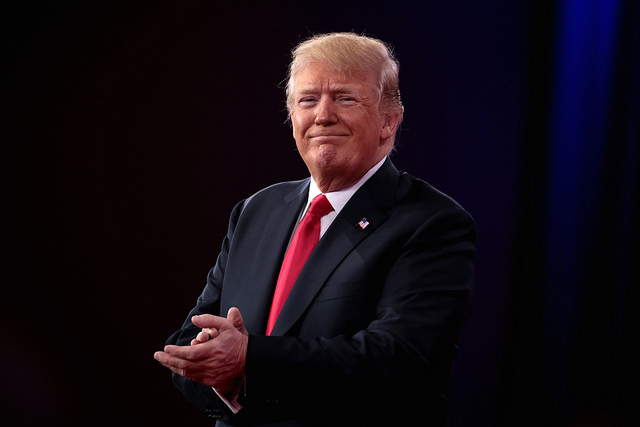
WASHINGTON — President Donald Trump is launching a campaign to end the HIV epidemic in the United States by 2030, targeting areas where new infections happen and getting highly effective drugs to people at risk.
Briefing reporters ahead of Trump’s State of the Union speech, Health and Human Services Secretary Alex Azar and senior public health officials said the campaign relies on fresh insights into where about half of new HIV cases occur — 48 out of some 3,000 U.S. counties, and Washington, D.C., Puerto Rico and seven states with at-risk rural residents.
“We’ve never had that kind of ‘This is the target,”’ said Dr. Anthony Fauci, the government’s pre-eminent AIDS warrior and head of the National Institute of Allergy and Infectious Diseases. The government has “been trying to address HIV, but never in such a focused way,” he said.
HIV is the virus that causes AIDS.
“Together, we will defeat AIDS in America and beyond,” Trump said in his speech. He pledged funding in his upcoming budget, but did not say how much.
Trump’s move is being greeted with a mix of skepticism and cautious optimism by anti-AIDS activists. They’re flagging his previous efforts to slash Medicaid health care for low-income people, and his administration’s ongoing drive to roll back newly won acceptance for LGBTQ people.
“We stand ready to work with him and his administration if they are serious,” said a statement from AIDS United and other groups. “But to date, this administration’s actions speak louder than words and have moved us in the wrong direction.” AIDS United funds and advocates policies to combat AIDS.
The ONE Campaign, the global anti-poverty group co-founded by rock singer Bono, called Trump’s pledge a “welcome sign,” but pointed out that the administration has also proposed deep cuts in U.S. funding for efforts to battle HIV in Africa.
“While we might have policy differences with the president and his administration, this initiative, if properly implemented and resourced, can go down in history as one of the most significant achievements of his presidency,” Michael Ruppal, executive director of the AIDS Institute, said in a statement.
While Azar said significant new funding would be included in the president’s budget, he also emphasized that the campaign is about making more efficient use of existing programs like the Ryan White HIV/AIDS Program, which provides medical care and support services.
“The tools are there,” Azar said. “This is about execution.”
Today’s HIV treatments work so well they not only can give people with the AIDS virus a near-normal life expectancy, they offer a double whammy — making those patients less likely to infect other people.
At the same time, a longtime HIV medication named Truvada can prevent infection if taken daily by healthy people who are at risk from their infected sexual partners, a strategy known as “pre-exposure prophylaxis” or PreP.
The people most at risk include men who have sex with men, minorities, particularly African-Americans, and American Indians/Alaska Natives. Azar said the administration’s campaign would rely on public health workers to identify people at risk for HIV/AIDS, get them tested, and on medication.
The 48 counties HHS is focusing on are mainly metro areas. The states are Alabama, Arkansas, Kentucky, Mississippi, Missouri, Oklahoma and South Carolina.
Researchers noted that will require working with groups that often shun health services, including injectable drug users.
“Trust is a crucial weapon in our fight to eradicate HIV and it’s necessary to encourage people from marginalized groups to get tested,” said Dr. Albert Wu, an HIV researcher at Johns Hopkins University.
The initial goal is to reduce new HIV infections by 75 per cent in five years.
There are about 40,000 new cases of HIV infections a year in the U.S. That’s a dramatic reduction from the crisis years of the AIDS epidemic, but progress has stalled. More than 1 million Americans live with the disease.
William McColl of AIDS United said the Trump administration’s goal is “very doable,” based on currently available technology and trends.
“I think the HIV community would work with the administration on this issue if they’re serious, but it’s also going to take real action, including possibly regulatory and legislative changes to achieve the goal,” said McColl.
Azar said the idea for the new push came from within the ranks of HHS.
“There was a recognition that we were facing a unique and historic moment where all the strands were coming together,” said Azar. They took the idea to Trump. “President Trump is personally invested in this,” said Azar.
In recent years a number of health organizations, including the United Nations, have called for co-ordinated steps to end the HIV epidemic by 2030.
Trump’s CDC director, Dr. Robert Redfield, told agency employees last March that it would possible to end the AIDS epidemic in less than seven years.
Shortly after taking office in 2010, President Barack Obama outlined a national HIV strategy focused on lowering the infection rate and increasing access to care. The administration renewed the five-year plan in 2015, though it did not set a goal of stopping transmission or ending the epidemic.
———
Associated Press writers Matthew Perrone and Lauran Neergaard contributed to this report.